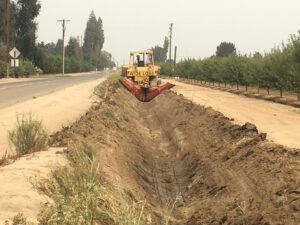
Alta Irrigation District wrapped up the 2020 irrigation season about mid-September and its crews jumped right into the remaining months of the 2020 maintenance season. While weedy ditches are common in Alta, recent District activity suggests this may not be the norm going forward.
Dinuba based Alta, which serves eastern Fresno County, northern Tulare County (east and south of the Kings River) and a slice of western Kings County, covers about 130,000 acres. Runoff from the Kings River is delivered to lands through a network of interconnected irrigation facilities such as earthen and concrete-lined ditches as well as pipelines. In total, there are approximately 250 miles of ditches (about 500 miles of ditch bank) and 80 miles of pipelines. The District’s 12-person field crew may have anywhere from about 1½ months during wet years (2017) to 10 months or more during dry years (2015) for maintenance activity.
Maintenance activity in September focused on mechanical weed removal from ditch banks and check structures along with plowing of small ditches with top widths about 15 feet or less. District’s weed removal efforts are visible along thoroughfares into the city of Dinuba that include Avenue 416 and Road 80 and into Sultana (Avenue 416 between Roads 100 and 104). As for plowing activity (see figure below), District General Manager Chad Wegley noted that over 10 miles of ditches were plowed during a three-week period following the end of water run, which is a record.
“Our ditch plow is the most cost-effective way to clean small ditches and when paired with our revamped spray program, ditches will not become overgrown with weeds,” said Wegley.
In 2017, the District was busy setting a record for the longest water run, 216 days, in the last half century, which pushed maintenance activity – sediment removal from Traver Canal (see figure below) – off until 2018. Since both 2017 and 2019 were wet water years with record setting water runs, District crews squeezed maintenance activities into small windows of opportunity lasting only a couple months each time. “’The District will continue with current maintenance activity and will be expanding its efforts to include replacing pipelines, installing slide gates on turnouts, and rehabilitating structures,” Wegley said. “Today’s maintenance activity reflects planning efforts from years past and this process will be repeated as the District looks to expand maintenance opportunities.”
“A 25% increase in headgate diversions during wet years, a five-fold increase in slide gate installations, and increased maintenance activity all serve as tangible proofs that Alta’s Board of Directors are engaged and fulfilling their oversight obligations,“ Wegley said. “Changes of these magnitudes do not happen by chance; they are the product of active management by leaders within an organization.”

As a farmer, I have been an Alta District customer for nearly 20 years. The beginning of our relationship was fraught with tension and hostile acts by older, white male ditch-tenders (who thankfully have since retired) because of my insistence that my ditch-banks not be sprayed with deadly pesticides. One ditch-tender came within inches of running into me with his truck after my attempts to speak to him through a rolled-up window that he refused to put down. When I called into the Alta office to report the incident, he claimed that the sun was in his eyes obscuring sight of me. The racist & sexist treatment I received ended once Glen Pilkerton came in as our new ditch-tender for the Bowhay irrigation line. We became fast friends as we rescued so many dogs & puppies abandoned along Alta ditches. I would often caution Glen to be careful of the deadly chemicals.Alta District sprayed up and down ditch banks. Tragically, Glen died last year at the age of 52 after a brave battle with cancer that I am firmly convinced was attributed to his exposure to the chemical sprays used by Alta Irrigation District. If we look at how other countries (think England) care for their waterways, you will see grass covering and water teaming with life. Here, our waters are dead and the ditch banks the best examples of soil erosion imaginable. Instead of investing in chemicals and heavy machinery that kill our soil and marine life, Alta needs to invest in acquiring the knowledge to re-establish healthy waterways and toxic-free water. Good for our soil, good for the crops we grow and good for the health of its employees and those of us who rely on ground surface irrigation flow.